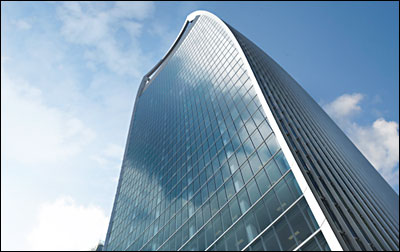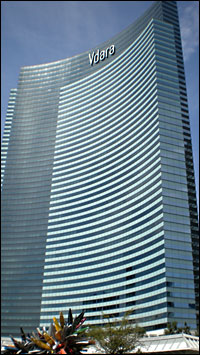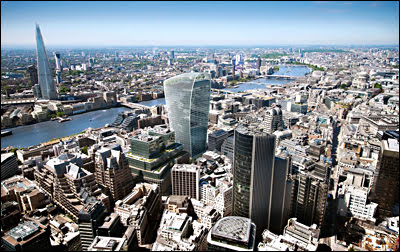By Melinda Rose, Senior Editor
A pan-European consortium aims to give city planners key environmental analytic tools, something that could prevent the building of another Jaguar-melting, egg-frying, cornea-searing "fryscraper."
The curved surface of the $378 million, 37-story tower under construction at 20 Fenchurch St. in London's financial district — nicknamed "The Walkie Talkie" for its top-heavy shape — concentrates and reflects sunlight hot enough to melt car parts, blister paint and fry an egg on the sidewalk, according to media reports. The light the skyscraper projects onto the streets below is so intense, some passersby have redubbed it "Walkie Scorchie."

The building under construction at 20 Fenchurch St. in London. The skyscraper was nicknamed "Walkie Talkie" for its top-heavy shape. But the way the curved surface concentrates and reflects sunlight hot enough to melt cars, blister paint and fray an egg has led locals to rename it "Walkie Scorchie." Courtesy of LandSecurities, Canary Wharf Group PLC.
Three parking spaces on a nearby street were closed after the owner of a Jaguar, along with several other car owners, complained that the ultrabright light melted parts of their vehicles. A two-story scaffold was also erected in the street to absorb the rays. The developers, Land Securities and Canary Wharf group, are "continuing to evaluate longer-term solutions" for the building, scheduled to be completed in March 2014.
“I’m flabbergasted,” said Dr. Philip Oldfield, an expert in tall buildings at the University of Nottingham’s department of architecture, who warned that other parts of London could be hit by the light beam.
“At street level, it’s unprecedented," Oldfield told City A.M., London's business newspaper. “The scary thing is that the light won’t always be on that part of the street. The sun angle will change through the next weeks and months – and in the winter the localized hot spot will have moved substantially.”

The Vdara Hotel in Las Vegas. The curved building, designed by the same architect as "Walkie Talkie," was dubbed a "death ray" when it opened in 2010 and swimming pool patrons were struck by reflected sunlight at certain times of day. Courtesy of Wikimedia Commons.
While the building's architect predicted a glare problem, he “didn't realize it was going to be so hot,” he told The Guardian newspaper last week.
"When it was spotted on a second design iteration, we judged the temperature was going to be about 36 degrees," architect Rafael Viñoly told the paper. "But it's turned out to be more like 72 degrees. They are calling it the 'death ray,' because if you go there, you might die. It is phenomenal, this thing."
Viñoly is also famous, or infamous, for designing the Vdara Hotel in Las Vegas, which, with its concave surface, also served as a gigantic light concentrator (See: Should Architects Learn Optics?). When the hotel opened in 2009, swimming pool guests reported that at certain times of the day, the reflected light was strong enough to singe hair and melt plastic drink cups and shopping bags. Hotel owner MGM Resorts International eased the problem by installing a high-tech film on the south-facing glass panes that scatters more than 70 percent of reflected rays.
"That was a completely different problem," said Viñoly, insisting he was following a master plan that specified arc-shaped towers. "We pointed out that would be an issue too, but who cares if you fry somebody in Las Vegas, right?"
The predicament highlights the need for city planners to use a more integrated approach, says the KIC-Transitions (KIC-T) project, a consortium led by Birmingham City University. The university is currently funded by the European Climate-KIC, an 18-month, €1.2 million ($1.6 million) project to combine some of the best academic minds from around Europe with industry partners and startup companies to create sustainable tools for those designing and planning cities.
An integrated platform such as KIC-T will allow cities to “plug in” a wide range of information sets for analysis of key environmental impacts, including energy needs, noise pollution or carbon emissions.
“Designers behind the Walkie Talkie building have cited climate change and even the lack of analytic tools as potential reasons for the so-called ‘death ray’ effect,” said professor Keith Osman, director of research at the university. “This has highlighted just how important our project will be in helping urban planners to better assess the impact such ambitious buildings will have when built in real city environments.”

Artist's concept of "Walkie Talkie" in relation to the London skyline. Courtesy of LandSecurities, Canary Wharf Group PLC.
Enhanced modeling capability being developed through KIC-T will help city planners, designers and residents better understand the full implications of planning decisions, Osman said, adding, “Currently, it is often extremely difficult to reuse or combine existing tools to investigate resource consumption, sustainability and assess the environmental impact and quality of life for citizens.”
The KIC-T project team also includes ETH Zurich and Netherlands Organization for Applied Scientific Research, plus large international companies including ESRI and IBM; small companies like Aria, SBC and Greenhill; and the three cities of Birmingham, Rotterdam and Zurich.
For more information, visit: www.climate-kic.org/themes/creating-sustainable-cities or www.20fenchurchstreet.co.uk